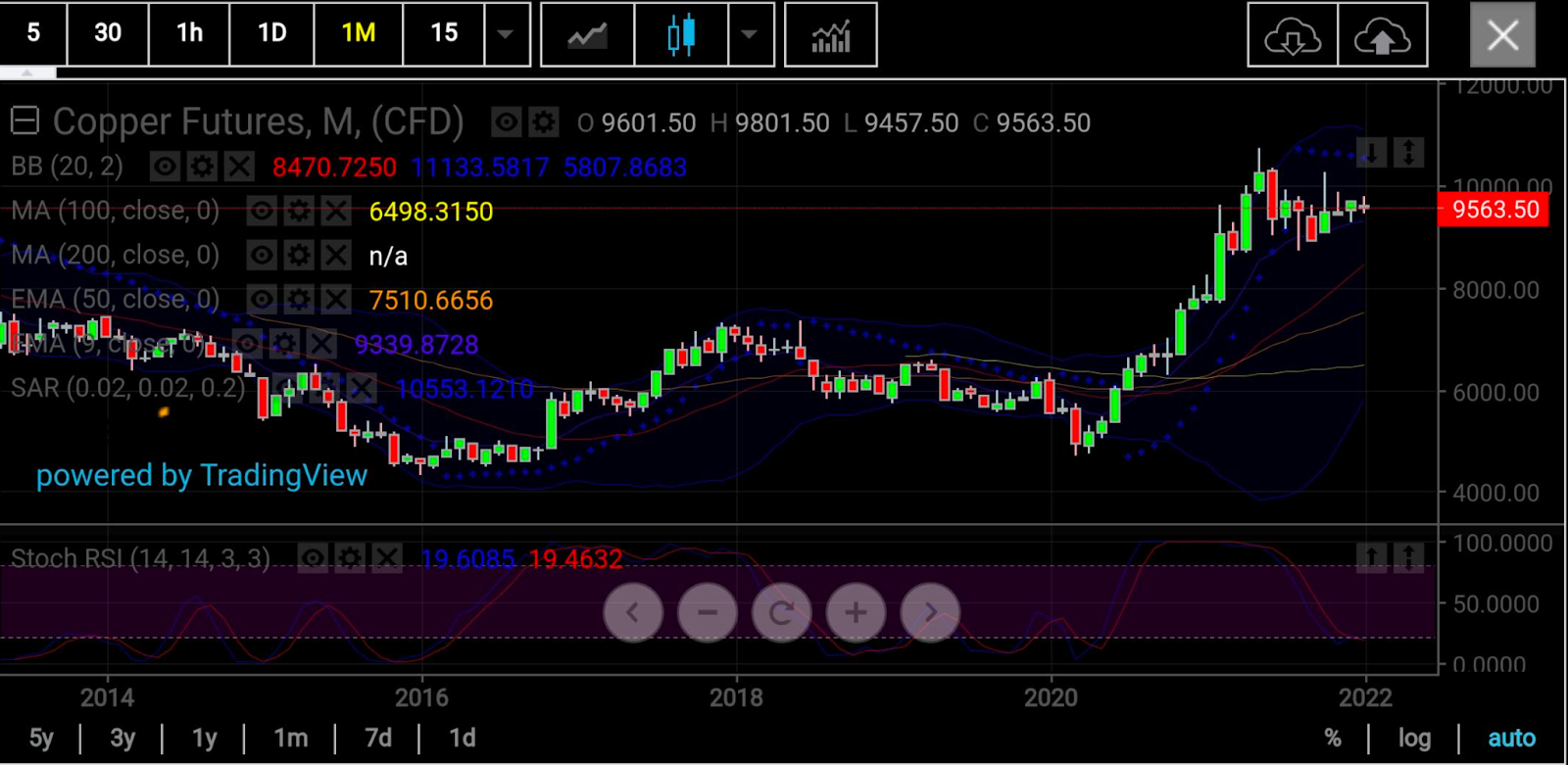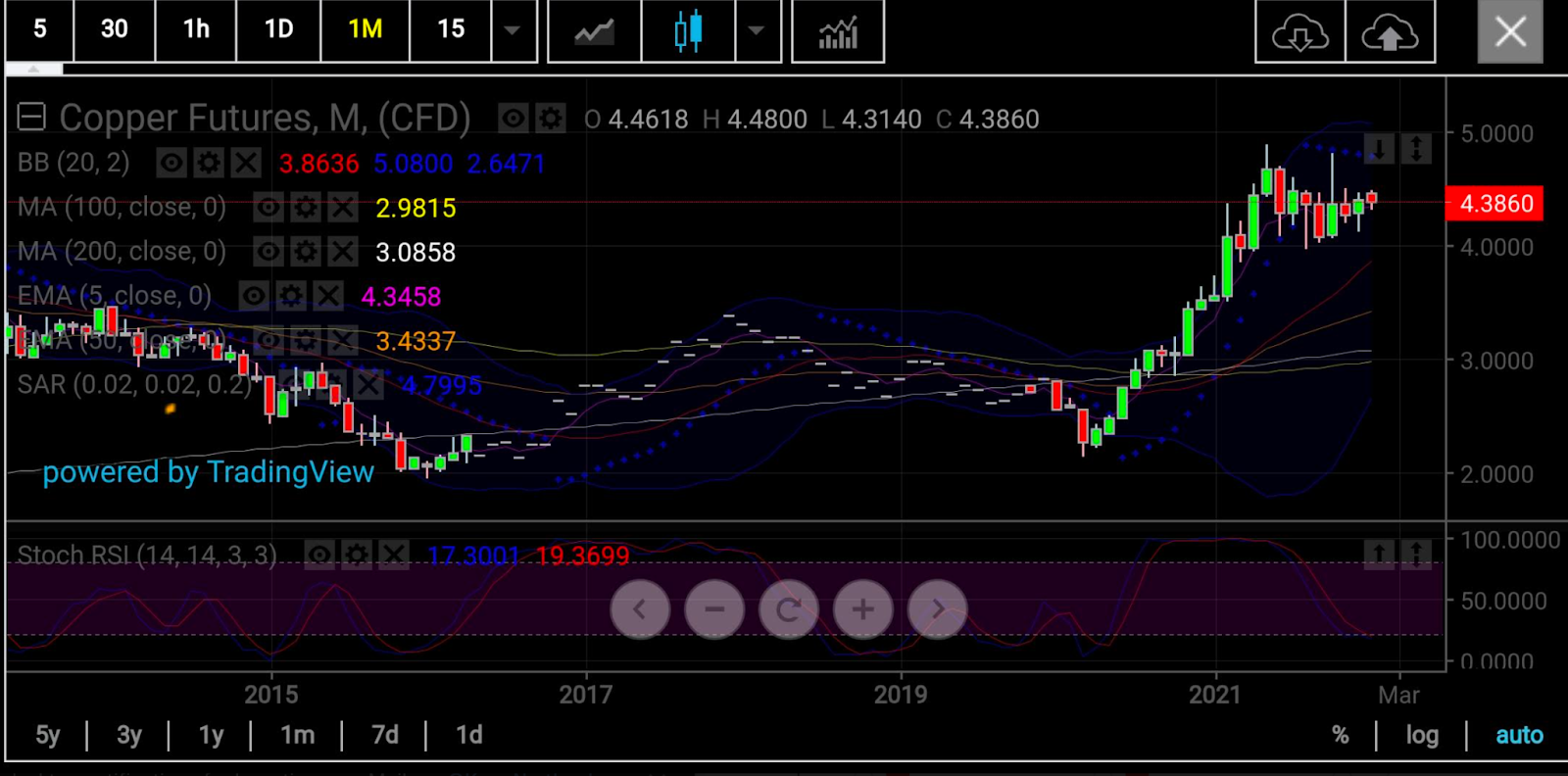Copper prices hit record highs last year and finished with their biggest gains since 2017. Traders hope that continued global recovery from the coronavirus pandemic will keep the rally going in the world’s leading industrial metal this year.
But world growth aside, nagging worries about the Chinese economy—and Beijing’s troubled history and transparency in dealing with COVID mutations—could dent the copper price, which relies inordinately on Chinese demand.
Underscoring those concerns, copper prices have started the year on a dull note, deeply off 2021 peaks.
Three-month copper on the London Metal Exchange finished last year up 25% at $9,720.50 per tonne, after a record high of $10,746 in May. This year so far, it’s down 1.6%, hovering at under $9,625.

All charts courtesy of skcharting.com
The front-month contract for US copper on New York’s COMEX also rose 25% in 2021, finishing at $4.40 per lb, after the all-time high of $4.888 set in May. Since 2022 began, it’s dipped 0.3%, hovering at just under $4.40.
The entire base metals space—consisting of copper, lead, zinc, aluminum and tin—performed outstandingly in 2021, making up for the slowdown of 2020, and this year should see a continuation of strong demand, “but with greater price volatility as the supply side recovers,” said Gavin Wendt, founding director at Mine Life, in a recent Bloomberg outlook on the sector.
On Monday, China was reported to have locked down a city of five million people, a day after detecting the Omicron variant of COVID in the central Henan province. It was the second city shut down in two months on concerns of a potential resurgence of the pandemic from highly transmissible variants.
While Beijing’s latest moves show its commitment to fight COVID at the most micro level, China’s transparency on the pandemic remains a concern to the world due to its spotty record in providing timely updates, statistics and warnings to other countries on its exposure and vulnerability to the virus.
Given the potential spread of Omicron ahead of the Beijing Winter Olympics—due to start in February—more Chinese cities are expected to tighten social distancing measures and even impose lockdowns around the Lunar New Year celebrations, which begin on Feb. 1, said Lu Ting, chief China economist at Nomura.
“Retail sales and the services sector could be severely hit again,” Ting wrote in a Nomura note on Sunday, published by the Hong Kong-based South China Morning Post. The economist said he expected corresponding cuts in growth forecasts for China’s economy in the first quarter.
Fundamentally, all these could weigh on copper, which relies on China for nearly 55% of its consumption.

Technically as well, copper’s outlook does not look promising, with an apparent bias to the downside, says Sunil Kumar Dixit, chief technical strategist at skcharting.com.
“Long term monthly charts for US copper show trades within a symmetrical triangle, with strong resemblance to flag pole patterns,” said Dixit.
He said COMEX metal prices have been moving sideways since failing to retest the May record high of $4.888.
“The falling stochastic reading of 17/19 gives some room for further decline,” added Dixit.
“The short term scenario shows the metal is range bound between $4.823-$3.966. Further moves will be better determined by which level breaks first.”
Three-month copper on the London Metal Exchange holds a similar formation to COMEX copper, noted Dixit. Adding:
“London prices have also been trading sideways within a symmetrical triangular flag pole pattern, with a narrowing of the angle every passing month.”
Dixit noted that since the May high of last year, trading in London copper has also been in a downward channel, ranging between $10,270 and $8,738.
“Trading on the weak side of $8,738 can push the LME copper down to the middle Bollinger Band® at $8,472 and the 50-month Exponential Moving Average of $7,512," Dixit said.
He added:
“Breaking above $10,270 may resume the main bullish trend that targets a retest of the $10,746 top and extend the rally to another 2,000 points reaching $12,800 over an extended period of time.”
Disclaimer: Barani Krishnan uses a range of views outside his own to bring diversity to his analysis of any market. For neutrality, he sometimes presents contrarian views and market variables. He does not hold a position in the commodities and securities he writes about.
